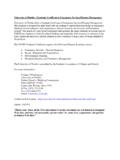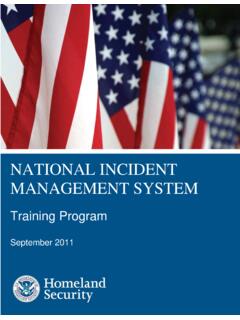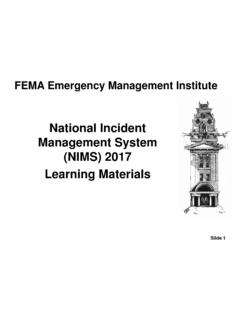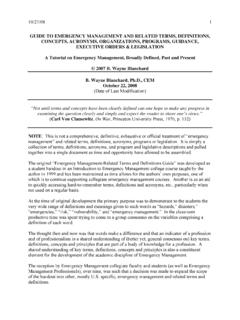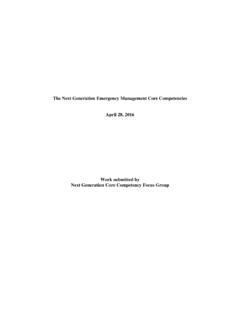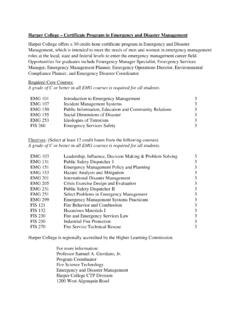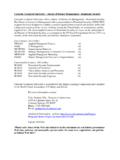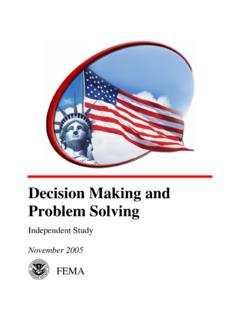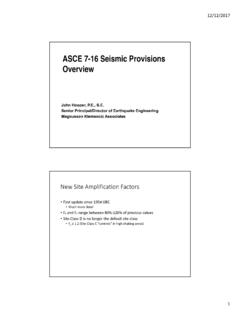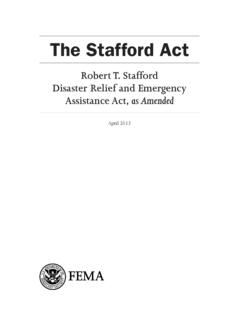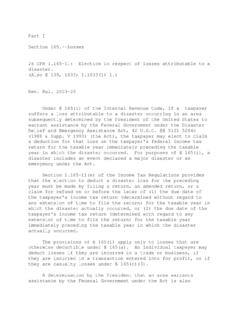Transcription of Unit Four Emergency Management in the United States
1 Livestock in Disasters / Unit 4 Emergency Management in the United States 4-1 Unit Four Emergency Management in the United States Overview This unit describes Emergency Management in the United States . It defines the four phases of Emergency Management , as well as other important terms used by Emergency managers. In addition, it describes the contributions of individuals and community, state, and federal agencies in making Emergency Management successful. Objectives Upon completion of this unit, you should be able to: Define the four phases of Emergency Management and describe activities associated with each phase Define basic Emergency Management terminology Describe the responsibilities of individuals and agencies at the community, state, and federal levels What Are Disasters?
2 The most common disasters result from meteorological (weather-related) and geological events and can affect any area of the Their impact can be localized or widespread, predictable or unpredictable. Damage can range from minimal to major. Depending on the severity of the incident, they can have a long-term impact on the infrastructure (roads, bridges, and utilities) of any location. Threats involving natural forces include thunderstorm, flood, tornado, hurricane, winter storm, drought, wildfire, landslide, earthquake , tsunami (tidal wave), volcano, and dam failure.
3 Technological (man-made) hazards include hazardous material releases and spills, acts of terrorism, and nuclear accidents. Natural hazards are usually, but not always, more predictable than any other type of hazard. Other threats include animal health emergencies, such as outbreaks of a Foreign Animal Disease. Although we cannot know exactly when or where disasters will strike, or how severe they will be, we recognize from past experience which geographical areas are most vulnerable to Livestock in Disasters / Unit 4 4-2 Emergency Management in the United States certain types of natural hazards.
4 This knowledge helps us better prepare for and respond to natural hazards. When you read through Units 5 15 on natural hazards, remember that each type of hazard has unique characteristics, yet common elements. These common elements allow you to prepare for and protect yourself and your animals from disaster. Four Phases of Emergency Management Emergency managers think of disasters as recurring events with four phases: Mitigation, Preparedness, Response, and Recovery. The following diagram illustrates the relationship of the four phases of Emergency Management .
5 The significance of the Emergency Management cycle is that all communities are in at least one phase of Emergency Management at any time. Livestock in Disasters / Unit 4 Emergency Management in the United States 4-3 Mitigation This phase includes actions taken to prevent or reduce the cause, impact, and consequences of disasters. Examples of hazard mitigation include: Tying down homes or barns with ground anchors to withstand wind damage Digging water channels to redirect water and planting vegetation to absorb water Constructing levees or permanent barriers to control flooding Reinforcing fencing to prevent animal escapes Buying insurance policies Preparedness This phase includes planning, training, and educational activities for events that cannot be mitigated.
6 Examples include: Developing disaster preparedness plans for what to do, where to go, or who to call for help in a disaster Exercising plans through drills, tabletop exercises, and full-scale exercises Creating a supply list of items that are useful in a disaster Walking around a farm and identifying possible vulnerabilities to high winds Livestock in Disasters / Unit 4 4-4 Emergency Management in the United States Response The response phase occurs in the immediate aftermath of a disaster. During the response phase, business and other operations do not function normally.
7 Personal safety and well-being in an Emergency and the duration of the response phase depend on the level of preparedness. Examples of response activities include: Implementing disaster response plans Conducting search and rescue missions Taking actions to protect yourself, your family, your animals, and others Addressing public perceptions about food safety Recovery During the recovery period, restoration efforts occur concurrently with regular operations and activities. The recovery period from a disaster can be prolonged. Examples of recovery activities include: Preventing or reducing stress-related illnesses and excessive financial burdens Rebuilding damaged structures based on advanced knowledge obtained from the preceding disaster Reducing vulnerability to future disasters Definitions of Emergency and Disaster The terms Emergency and disaster often are used interchangeably.
8 This common use of terms can be confusing. It is easiest to understand the terms Emergency and disaster as being at two ends of a scale, in which the size of an incident and the resources to deal with the incident are matched to varying degrees. Emergency At one end of the spectrum, emergencies are usually small-scale, localized incidents which are resolved quickly using local resources. However, small-scale emergencies can escalate into disasters when there has been inadequate planning and wasteful use of resources. Livestock in Disasters / Unit 4 Emergency Management in the United States 4-5 Disaster At the other end of the spectrum, disasters are typically large-scale and cross geographic, political, and academic boundaries.
9 Disasters require a level of response and recovery greater than local communities can provide. Emergencies and disasters and the livestock industry Emergencies and disasters involving livestock also vary in degree, depending on the amount and availability of needed resources. The degree to which an incident results in a disaster depends on the size of the event and local response and recovery capabilities. In many cases, levels of preparedness, response, and recovery capabilities go hand-in-hand. For example, in the 1998 ice storm in the northeastern , the most critical agricultural need was for electrical generators.
10 Dairy farms suffering power outages depended on electricity to milk their cows. Farmers who had adequate-sized generators and who knew how to operate them faced an Emergency because they were only temporarily prevented from milking their cows. In contrast, farmers without generators, or with generators that failed due to lack of adequate maintenance or fuel, were faced with disastrous consequences. They could not milk their cows and suffered great production losses. Their cows became ill and, in some cases, died. Foreign animal disease Foreign Animal Disease outbreaks, such as Foot and Mouth Disease or Classical Swine Fever (Hog Cholera), could have a negative impact on the national food supply and pose a major threat to production and international trade.
